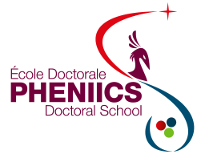Orateur
Mlle
Inna Kucher
(CEA Saclay)
Description
A search for the Higgs boson produced in association with a pair of top quarks and its decay to two photons has been performed by the CMS Collaboration at the LHC experiment using pp collisions at a center-of-mass energy of 13TeV with an integrated luminosity of 2.6/fb. This associated production is the only direct access to the top quark Yukawa coupling and decay to two photons has very clean signature in the detector as well as mass resolution ~ 1%. To have a good sensitivity of the analysis it is very important to keep the good diphoton mass resolution, which depends on the photon energy and the angle between two photons.
In the Higgs boson decaying to two photons analysis the vertex indentification algorithm had to be revised for Run II conditions. In the decay of the Higgs boson into two photons, the unconverted final state photons are not detected in the tracker, so the determination of the associated primary vertex is not trivial. Moreover, the CMS electromagnetic calorimeter has no longitudinal segmentation, it is thus not a pointing calorimeter. The information from the recoiling tracks, and, when at least one of the photons is converted into electron-positron pair in the tracker, from the conversion tracks can be used to determine the primary vertex. The algorithm is described in this presentation together with its performance.
Auteur principal
Mlle
Inna Kucher
(CEA Saclay)



